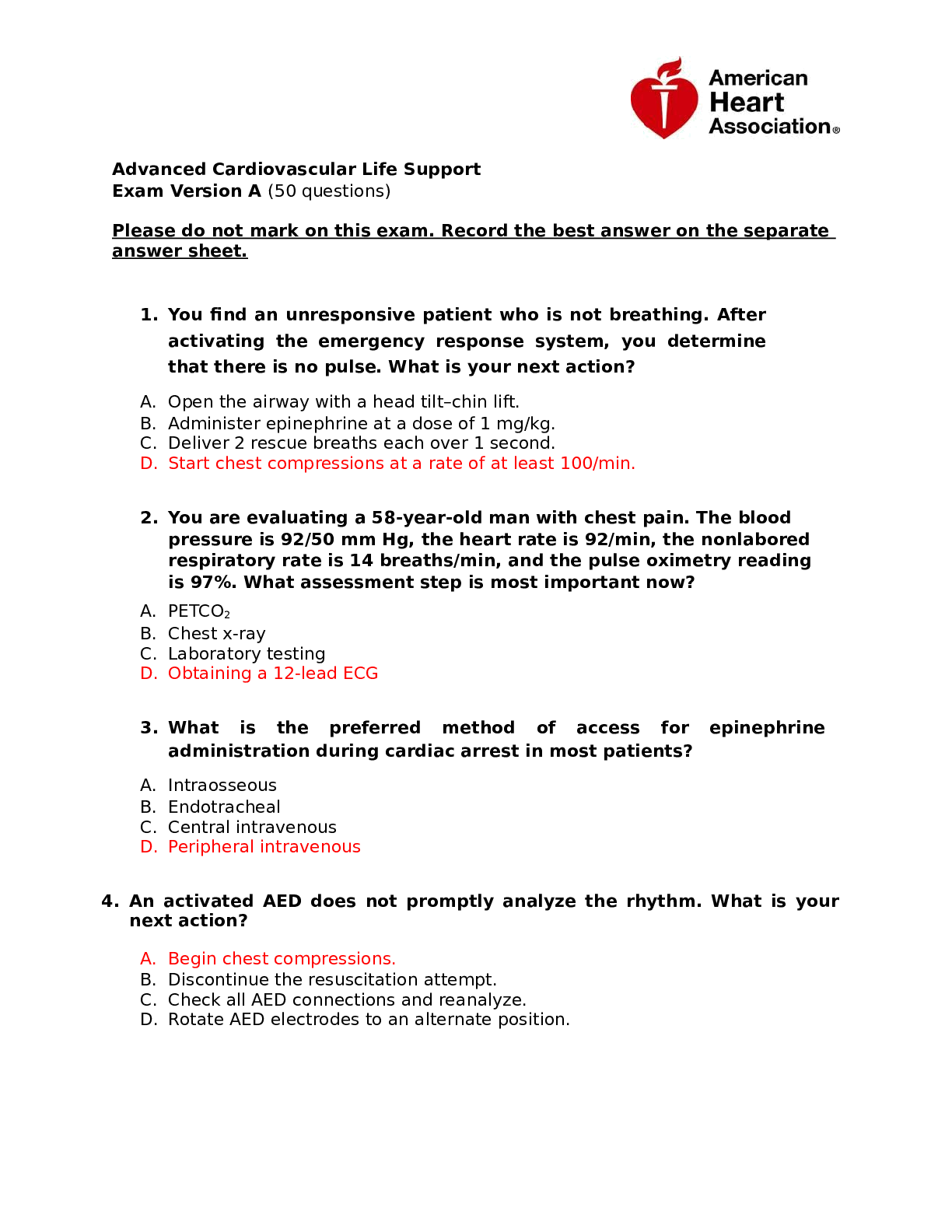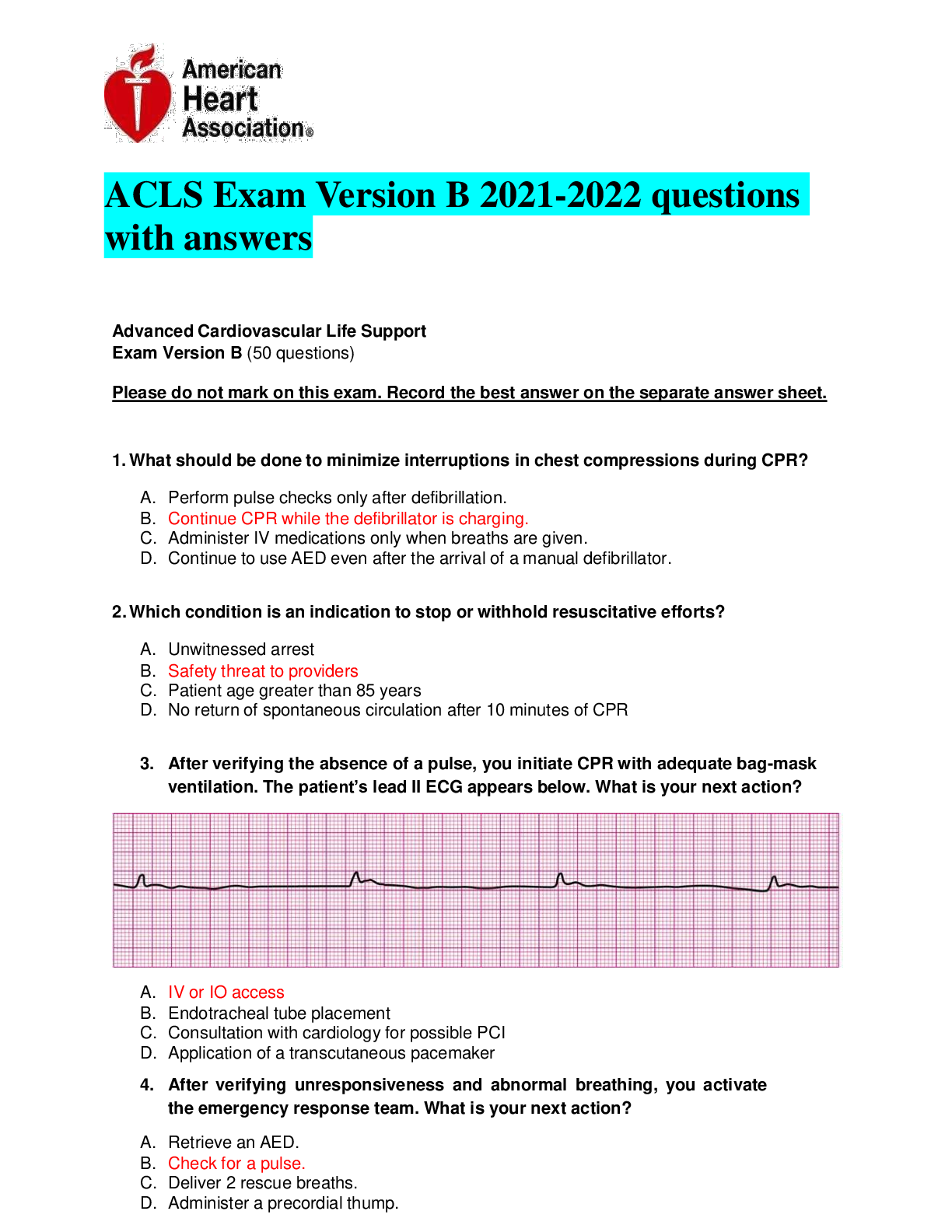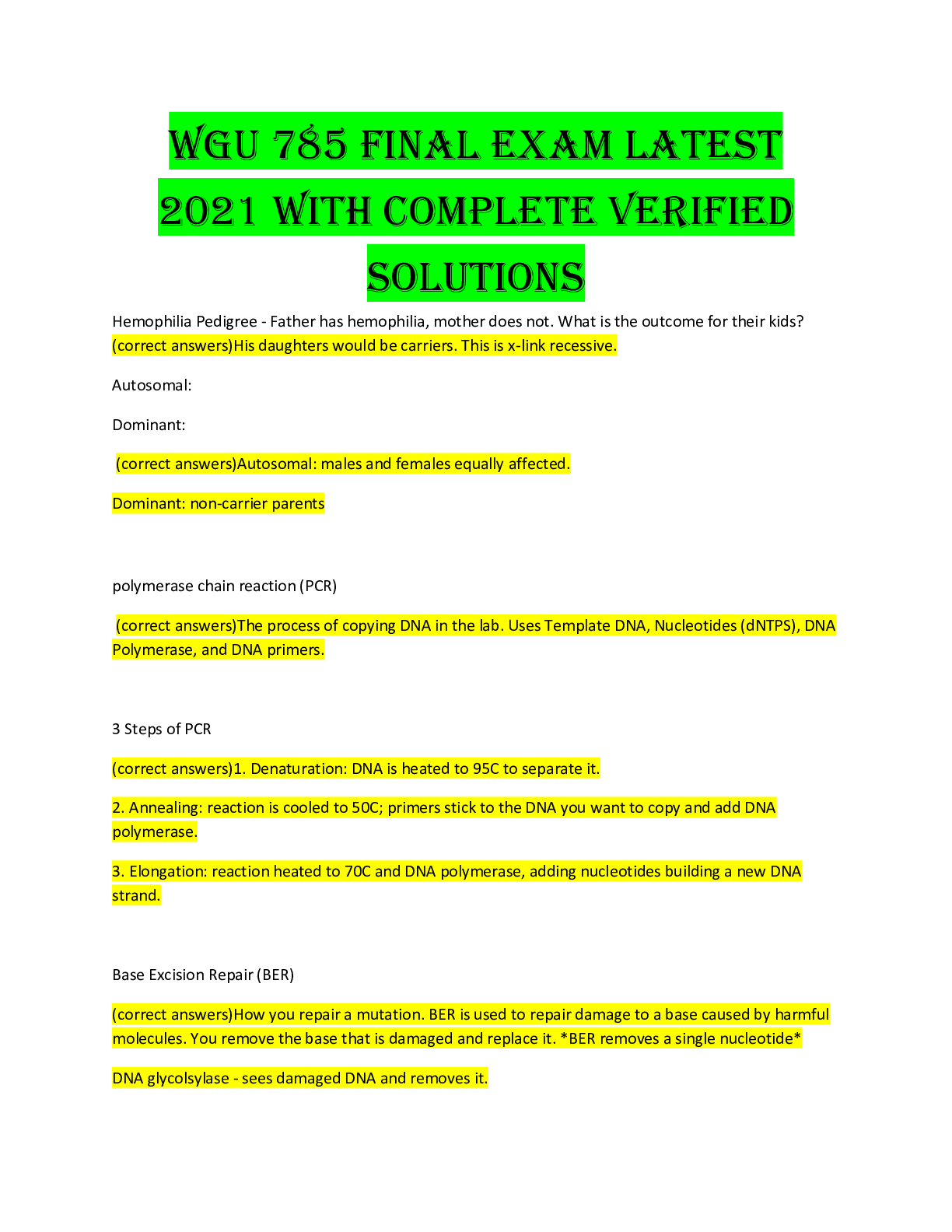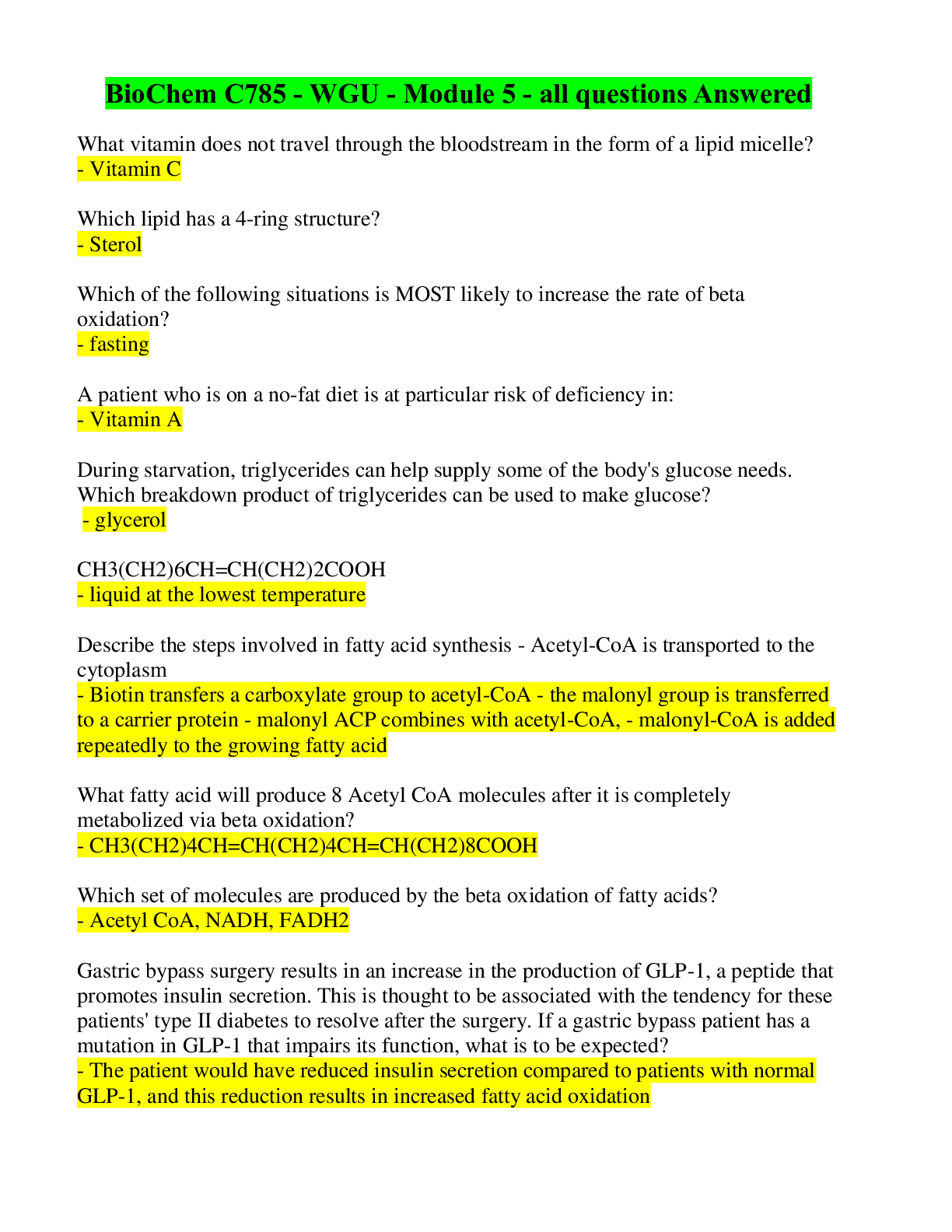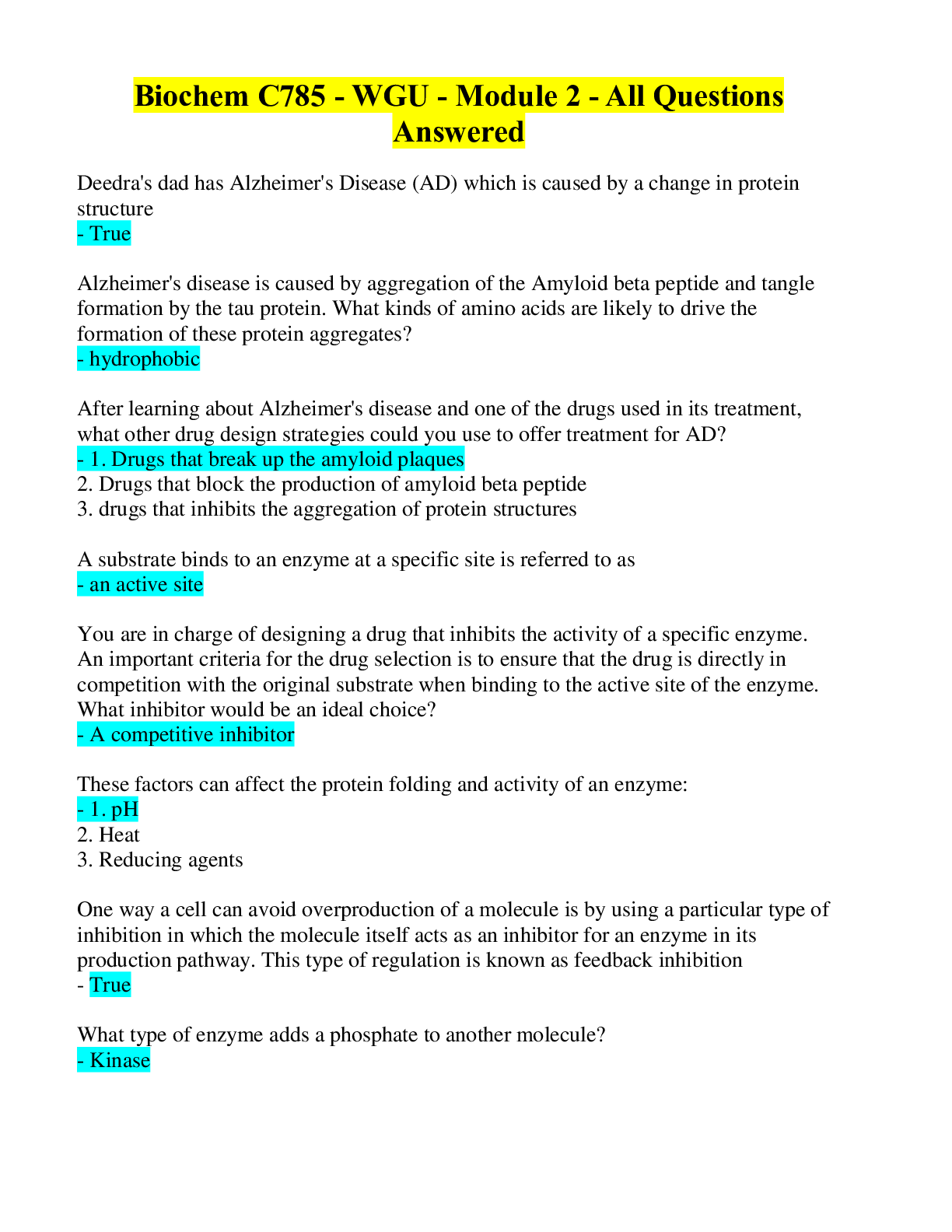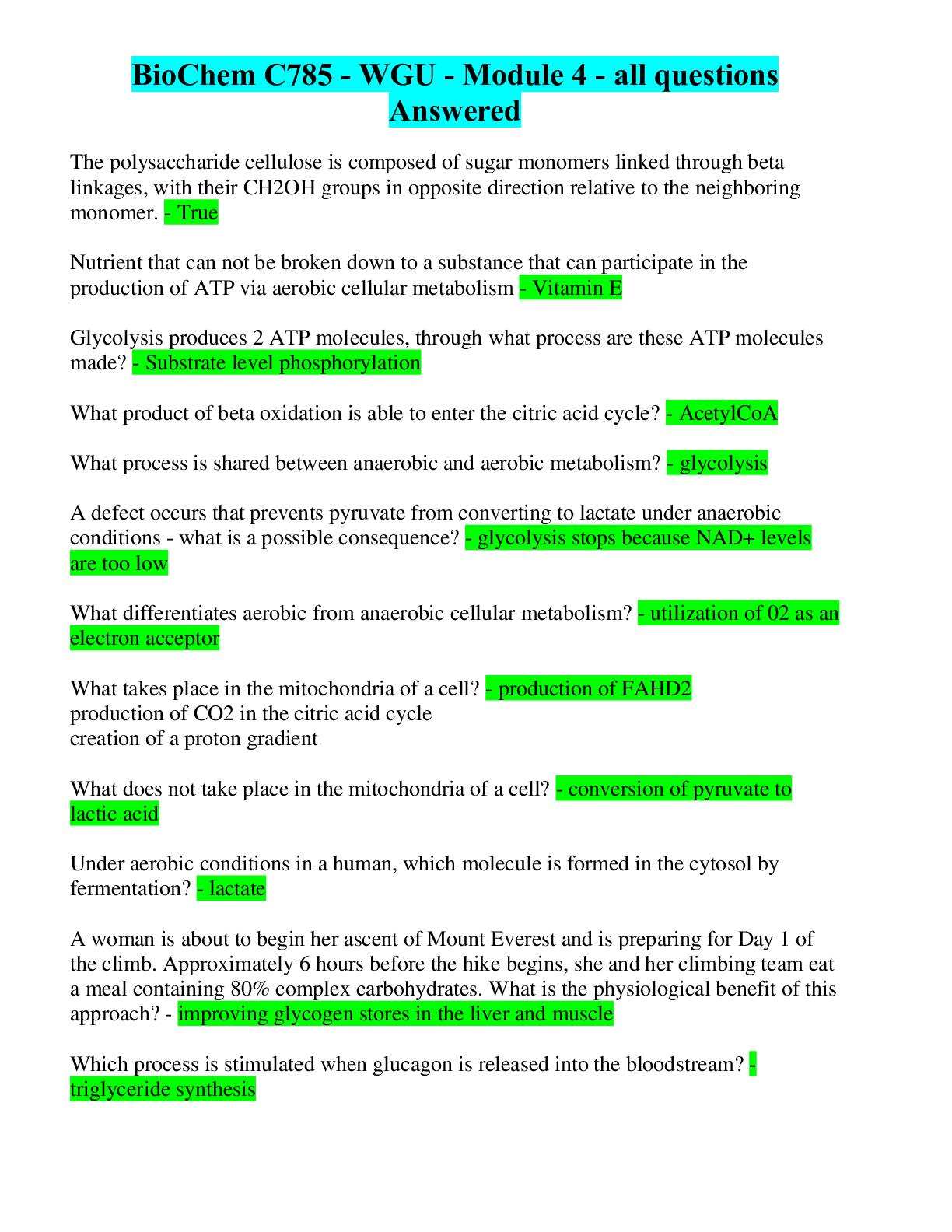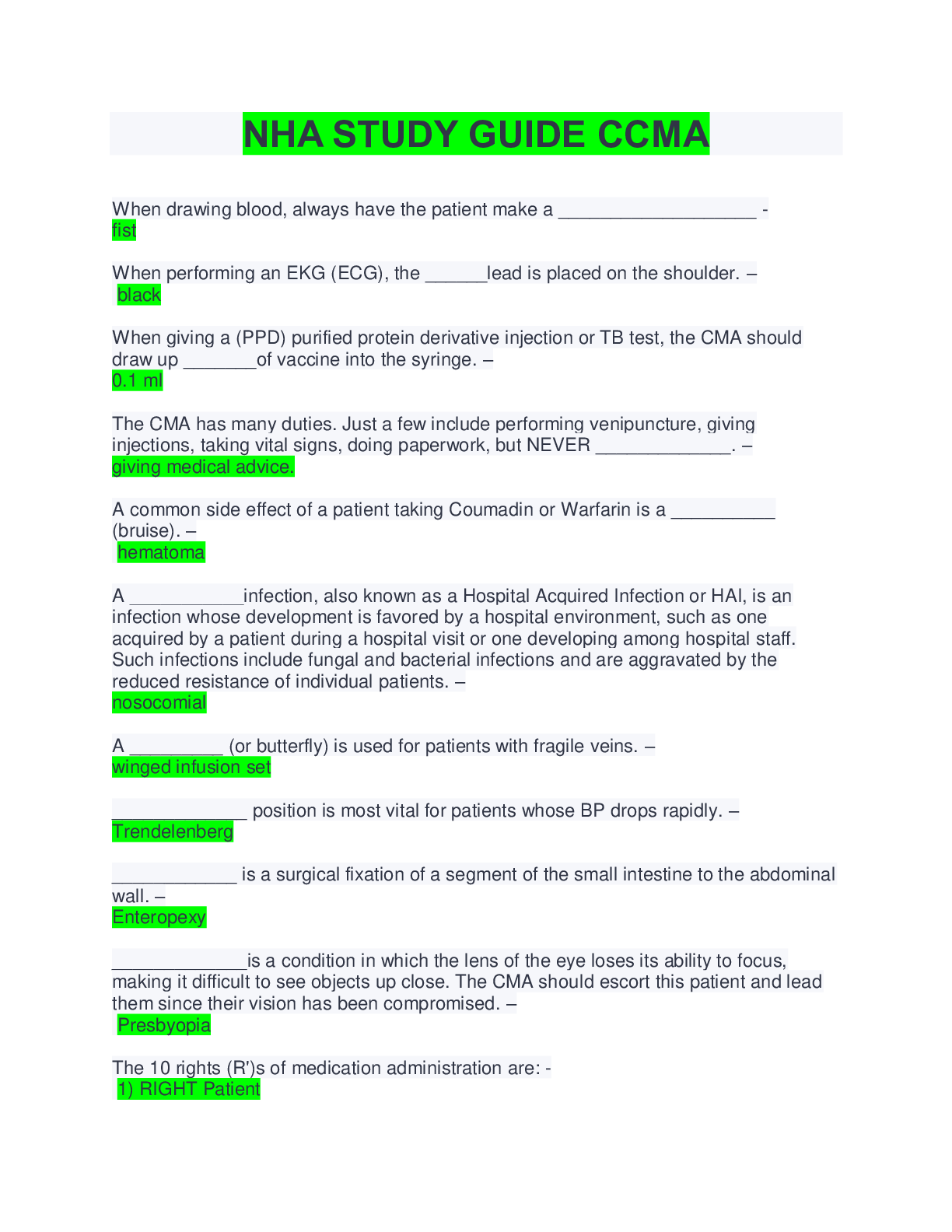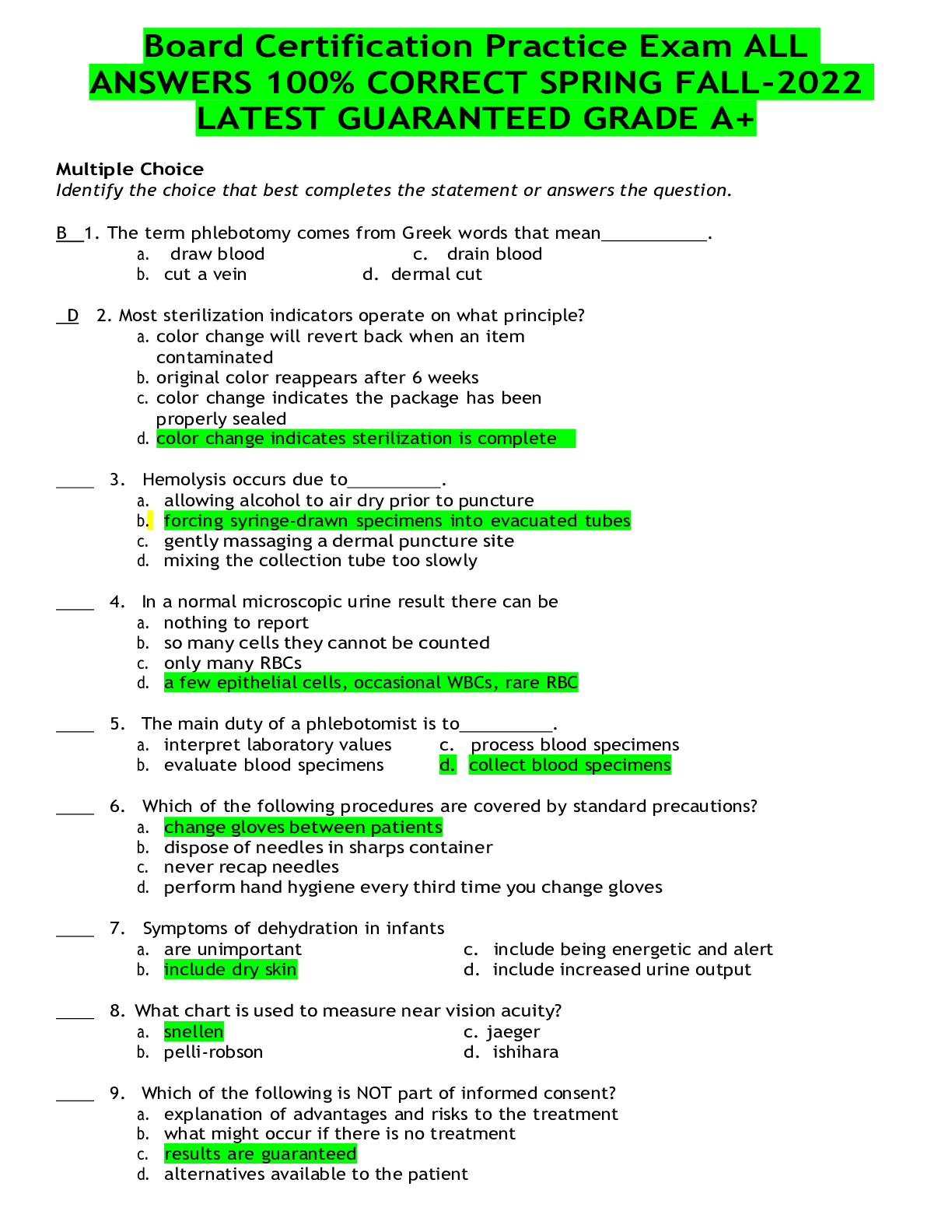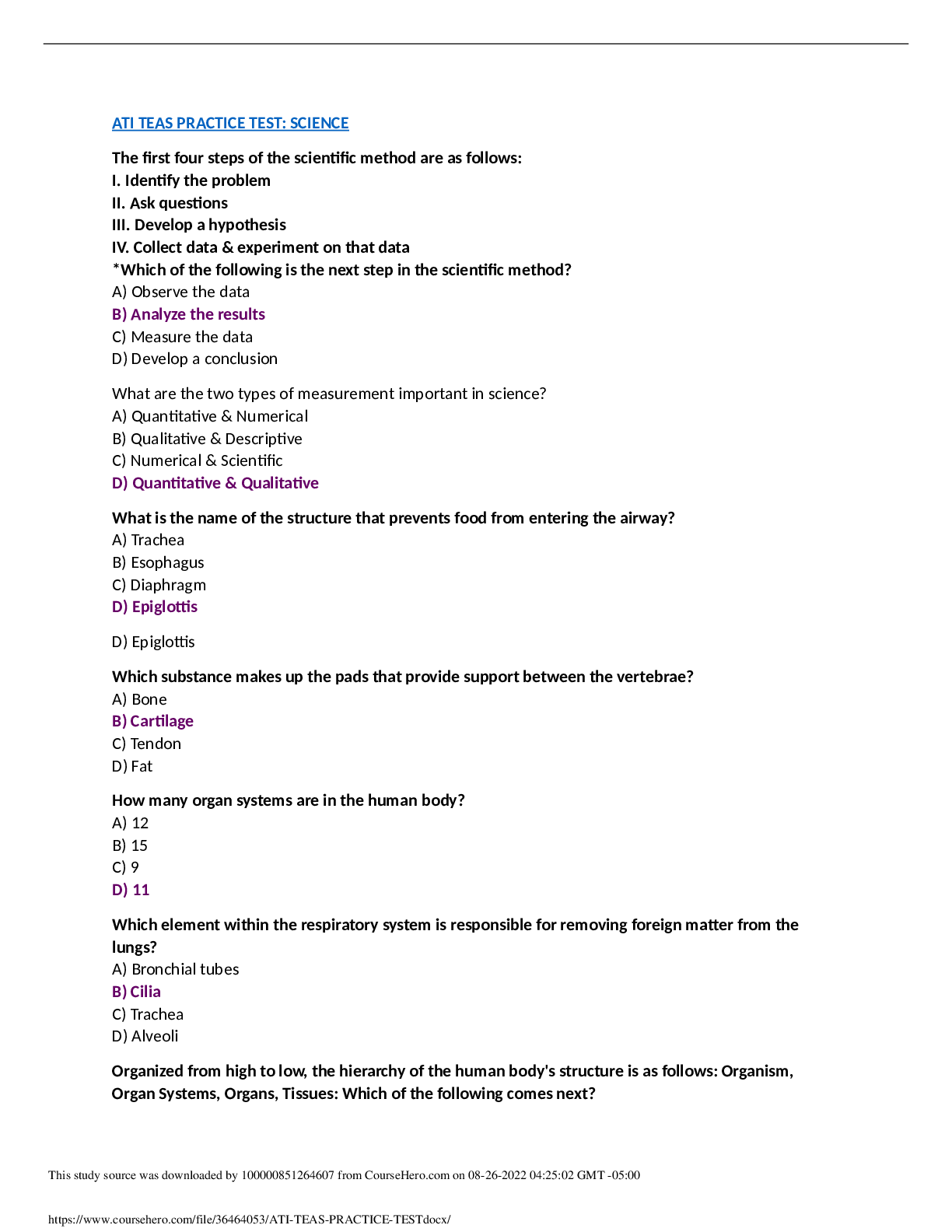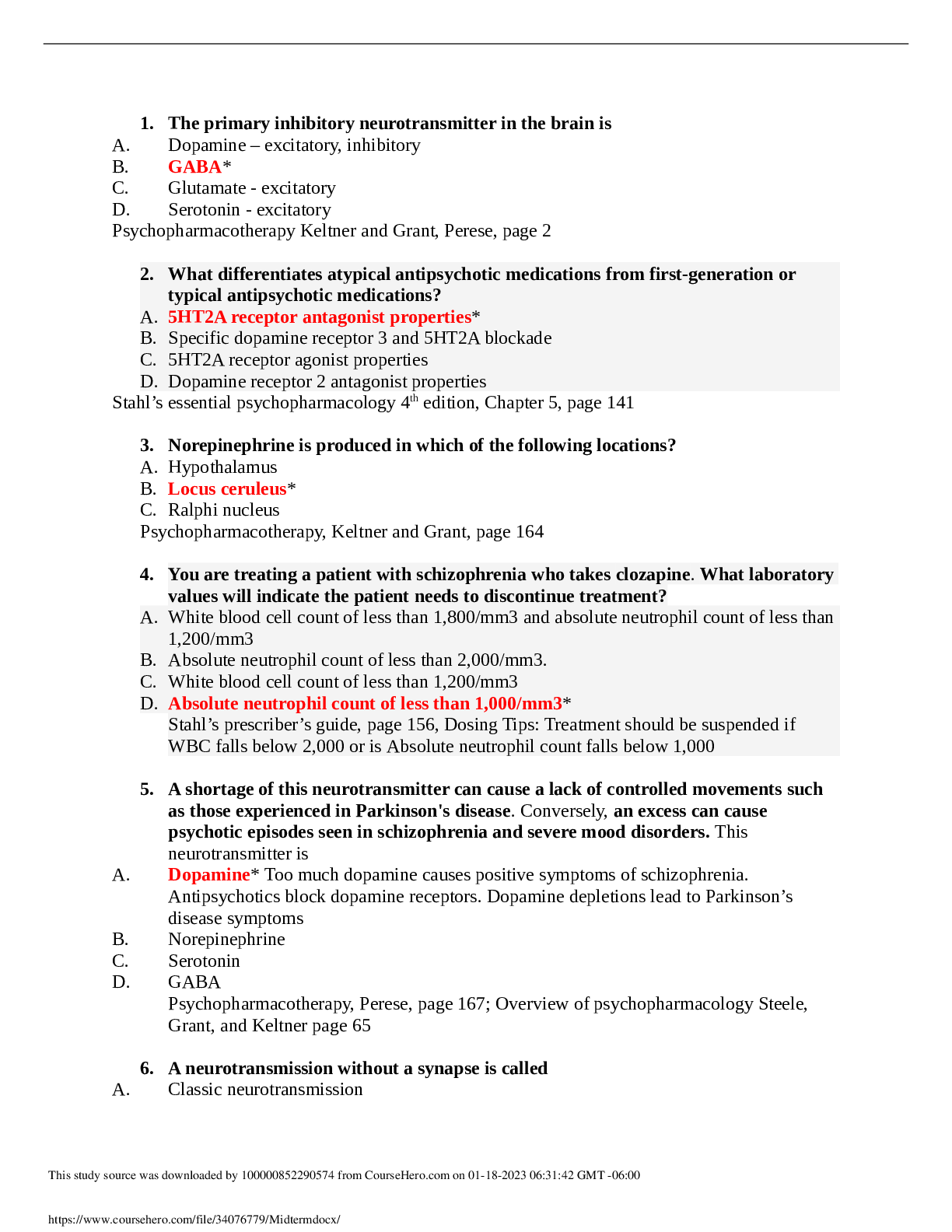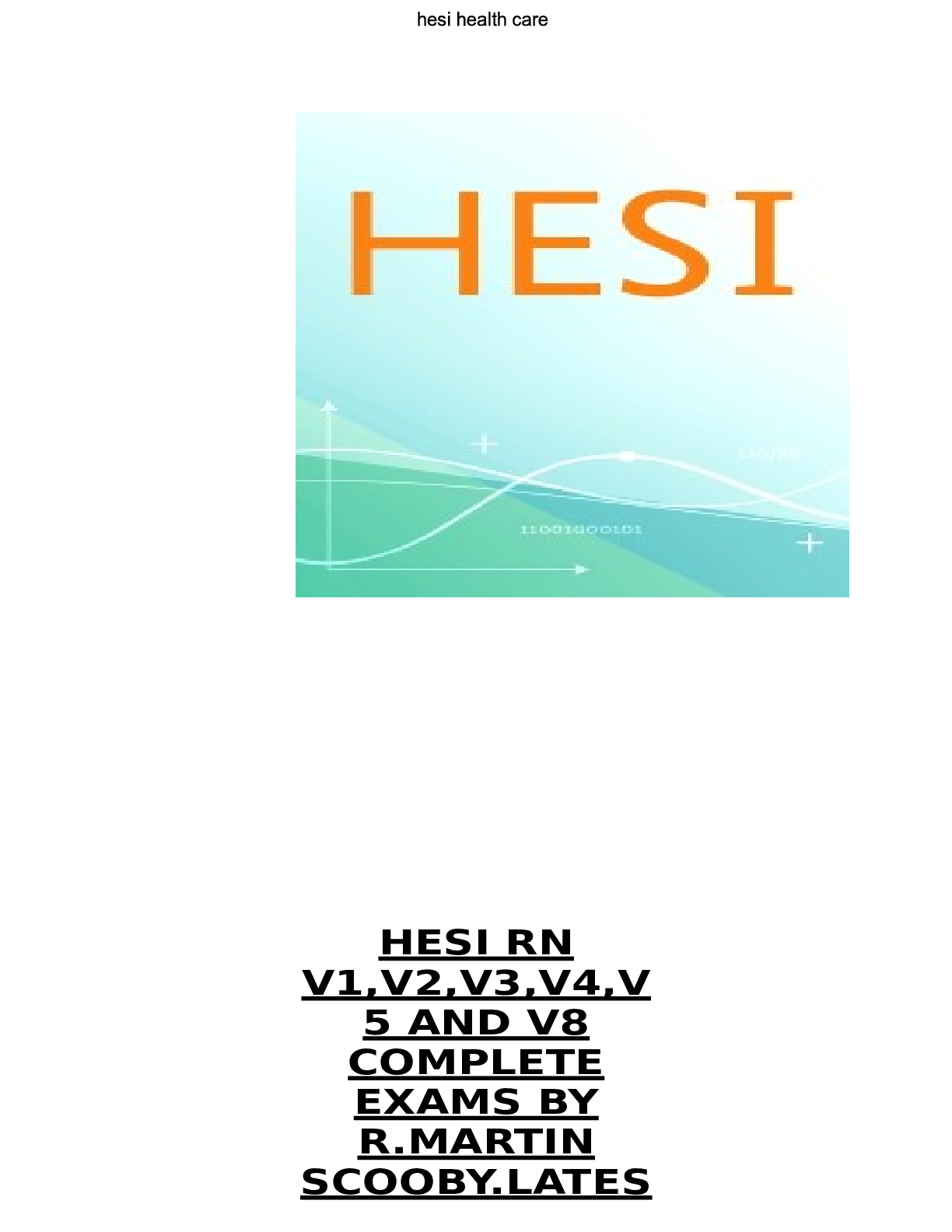Biology > QUESTIONS & ANSWERS > BIOL MICRO BIOLO exams. rated 5 star(download to get an A+ in your exams) (All)
BIOL MICRO BIOLO exams. rated 5 star(download to get an A+ in your exams)
Document Content and Description Below
Question 1 of 50 2.0/ 2.0 Points Which of the following are considered primary requirements of life for a multi-celled organism? E. All the above are primary requirements of life for a multi-celled... organism. Feedback: Good work; your answer is correct! Question 2 of 50 2.0/ 2.0 Points A collection of similar tissues that performs a specific function is an ________. C. organ Feedback: Good work; your answer is correct! Question 3 of 50 2.0/ 2.0 Points Physiology… B. explains how the structures of the body work together to maintain life. Feedback: Good work; your answer is correct! Question 4 of 50 2.0/ 2.0 Points If some condition of the body needs to be returned to its “set point”, i.e. homeostasis, then a(n) _________ feedback loop comes into play. D. negative Feedback: Good work; your answer is correct! Question 5 of 50 2.0/ 2.0 Points Organization, metabolism, responsiveness, movement, development, growth and reproduction all together are called __________ of a human body. A. functions Feedback: Good work; your answer is correct! Question 6 of 50 2.0/ 2.0 Points The following are all levels of the structural organization of the human body: 1. Organ 2. Organ system 3. Tissue 4. Cell 5. Chemical level Arrange the above levels from least complex to most complex: A. 5, 4, 3, 1, 2 Feedback: Good work; your answer is correct! Part 2 of 7 - Part 2 10.0/ 10.0 Points From Chapter 7 Question 7 of 50 2.0/ 2.0 Points The thoracic cage (rib cage) forms the thorax (chest) portion of the body. It consists of the _______ pairs of ribs and the _______. C. 12; sternum Feedback: Good work; your answer is correct! Question 8 of 50 2.0/ 2.0 Points Each bone of the body serves a particular function, and therefore bones __________. C. vary in size, shape, and strength. Feedback: Good work; your answer is correct! Question 9 of 50 2.0/ 2.0 Points The lambdoid suture joins the parietal bone to the ________. A. occipital bone Feedback: Good work; your answer is correct! Question 11 of 50 2.0/ 2.0 Points The thoracic cage protects the ______. E. Heart and lungs Feedback: Good work; your answer is correct! Part 3 of 7 - Part 3 18.0/ 18.0 Points From chapter 1 Question 12 of 50 2.0/ 2.0 Points Which organ system is responsible for controlling water balance in the body and removing waste from blood and excreting it? C. Urinary system Feedback: Correct. This can be found in the OpenStax Overview of Anatomy and Physiology section. Section 1.2. Question 13 of 50 2.0/ 2.0 Points What is human anatomy? D. The scientific study of the body's structures. Feedback: Correct. This can be found in the OpenStax Overview of Anatomy and Physiology section. Section 1.1. Question 14 of 50 2.0/ 2.0 Points Which organ system is responsible for enabling movement and helping to maintain body temperature? C. Muscular system Feedback: Correct. This can be found in the OpenStax Overview of Anatomy and Physiology section. Section 1.2. Question 15 of 50 2.0/ 2.0 Points What is human physiology? C. The scientific study of the body's functions. Feedback: Correct. This can be found in the OpenStax Overview of Anatomy and Physiology section. Section 1.1. Question 16 of 50 2.0/ 2.0 Points This is the highest level of organization and can independently perform all the physiologic functions necessary for life. D. Organism Feedback: Correct. This can be found in the OpenStax Overview of Anatomy and Physiology section. Section 1.2. Question 17 of 50 2.0/ 2.0 Points In a negative feedback system, what is component that causes a change to reverse the situation and return to the value in the normal range? D. Effector Feedback: Correct. This can be found in the OpenStax Overview of Anatomy and Physiology section. Section 1.5. Question 18 of 50 2.0/ 2.0 Points Which body function is responsible for increasing the number of existing cells, increasing, the amount of non-cellular material around cells, and increasing the size of existing cells? D. Growth Feedback: Correct. This can be found in the OpenStax Overview of Anatomy and Physiology section. Section 1.3. Question 19 of 50 2.0/ 2.0 Points The state of steady internal conditions maintained by living things is called this. D. Homeostasis Feedback: Correct. This can be found in the OpenStax Overview of Anatomy and Physiology section. Section 1.1. Question 20 of 50 2.0/ 2.0 Points Every cell in the body uses what chemical compound to store and release energy. C. Adenosine Triphosphate (ATP) Feedback: Correct. This can be found in the OpenStax Overview of Anatomy and Physiology section. Section 1.3. Part 4 of 7 - Part 4 6.0/ 6.0 Points From chapter 1.6 Question 21 of 50 2.0/ 2.0 Points Which body plane divides the body or organ horizontally into upper and lower portions? D. Transverse plane Feedback: Correct. This can be found in the OpenStax Overview of Anatomy and Physiology section. Section 1.6. Question 22 of 50 2.0/ 2.0 Points This directional term describes the middle or direction towards the middle of the body. C. Medial Feedback: Correct. This can be found in the OpenStax Overview of Anatomy and Physiology section. Section 1.6. Question 23 of 50 2.0/ 2.0 Points How many abdominal regions are there? D. 9 Feedback: Correct. This can be found in the OpenStax Overview of Anatomy and Physiology section. Section 1.6. Part 5 of 7 - Part 5 4.0/ 4.0 Points From chapter 1.7 Question 24 of 50 2.0/ 2.0 Points Which medical imaging technique are best used to visualize hard body structures such as teeth and bones? D. X-ray imaging Feedback: Correct. This can be found in the OpenStax Overview of Anatomy and Physiology section. Section 1.7. Question 25 of 50 2.0/ 2.0 Points Which medical imaging technique uses radiopharmaceutical tracing to reveal metabolic and physiological functions in tissues? C. Positron emission tomography (PET) Feedback: Correct. This can be found in the OpenStax Overview of Anatomy and Physiology section. Section 1.7. Part 6 of 7 - Part 6 10.0/ 10.0 Points From chapter 7 Question 26 of 50 2.0/ 2.0 Points What unites the bodies of adjacent vertebrae? B. Intervertebral discs Feedback: Correct. This can be found in the OpenStax Overview of Anatomy and Physiology section. Section 7.3. Question 27 of 50 2.0/ 2.0 Points How many vertebrae are located in the thoracic region? C. 12 Feedback: Correct. This can be found in the OpenStax Overview of Anatomy and Physiology section. Section 7.3. Question 28 of 50 2.0/ 2.0 Points How many vertebrae are located in the lumbar region? C. 5 Feedback: Correct. This can be found in the OpenStax Overview of Anatomy and Physiology section. Section 7.3. Question 29 of 50 2.0/ 2.0 Points True ribs are which of these? A. Attached via their costal cartilage directly to the sternum Feedback: Correct. This can be found in the OpenStax Overview of Anatomy and Physiology section. Section 7.4. Question 30 of 50 2.0/ 2.0 Points The thickest portions of the anterior longitudinal ligament and the supraspinous ligament are found in which regions of the vertebral column? A. Cervical Feedback: Correct. This can be found in the OpenStax Overview of Anatomy and Physiology section. Section 7.3. Part 7 of 7 - Part 7 38.0/ 40.0 Points From chapter 2 Question 31 of 50 2.0/ 2.0 Points Inorganic compounds typically do not contain which atoms? A. Carbon Feedback: Correct. This can be found in the OpenStax Overview of Anatomy and Physiology section. Section 2.4. Question 32 of 50 2.0/ 2.0 Points The energy stored in a foot of snow on a steep roof is what kind of energy? C. Potential Feedback: Correct. This can be found in the OpenStax Overview of Anatomy and Physiology section. Section 2.3. Question 33 of 50 2.0/ 2.0 Points Together, just four elements make up more than 95 percent of the body’s mass. Which ones are they? D. oxygen, carbon, hydrogen, and nitrogen Feedback: Correct. This can be found in the OpenStax Overview of Anatomy and Physiology section. Section 2.1. Question 34 of 50 2.0/ 2.0 Points What are organic compounds, such as carbohydrates, lipids, proteins, and nucleic acids, within the human body often referred to as? B. Macromolecules Feedback: Correct. This can be found in the OpenStax Overview of Anatomy and Physiology section. Section 2.5. Question 35 of 50 2.0/ 2.0 Points A substance formed of crystals of equal numbers of cations and anions held together by ionic bonds is called what? D. Salt Feedback: Correct. This can be found in the OpenStax Overview of Anatomy and Physiology section. Section 2.2. Question 36 of 50 2.0/ 2.0 Points A saturated fatty acid has the maximum number of which atoms in its chain? C. Hydrogen Feedback: Correct. This can be found in the OpenStax Overview of Anatomy and Physiology section. Section 2.5. Question 37 of 50 [Show More]
Last updated: 1 year ago
Preview 1 out of 272 pages
Instant download

Buy this document to get the full access instantly
Instant Download Access after purchase
Add to cartInstant download
Reviews( 0 )
Document information
Connected school, study & course
About the document
Uploaded On
Sep 10, 2021
Number of pages
272
Written in
Additional information
This document has been written for:
Uploaded
Sep 10, 2021
Downloads
0
Views
46

